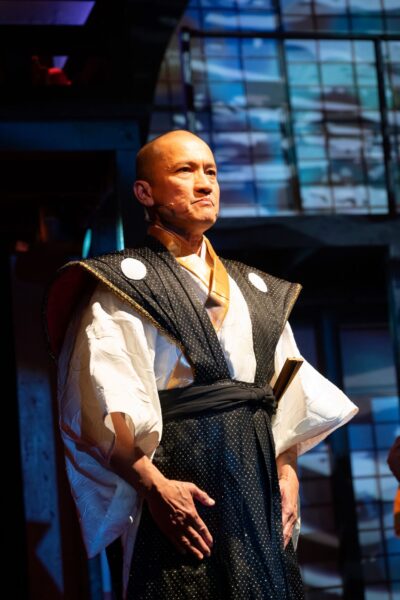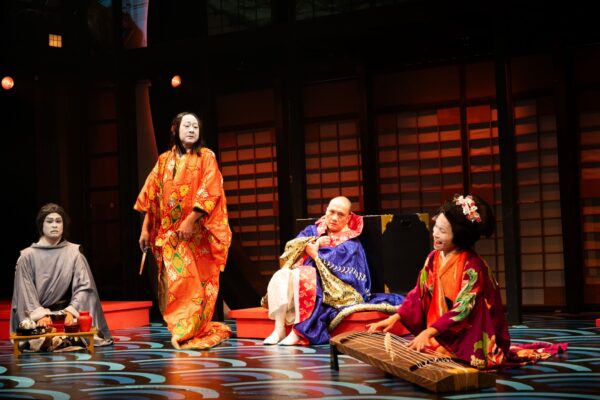EAST WEST PLAYERS PULLS OUT ALL THE SHOGUNS
FOR A RARELY SEEN SONDHEIM MUSICAL
On Sunday, East West Players opened their new production of Pacific Overtures by Stephen Sondheim (music and lyrics) and John Weidman (book). From 1976, this is one of Sondheim’s more overlooked shows. If you’ve never seen this unusual musical, this will likely be your only chance for a long time, and you should stop reading and just go. If, like me, you’ve been cursed by having seen an intimate, faithful and arresting production previously, then I wouldn’t consider this new one essential. But how many of you have seen a small production, let alone seen it at all? Plus, it’s still Sondheim, who rose to the strikingly original but thin book’s challenge to communicate drama through song, and his results are stunning; his customary devilishily witty and delightful lyrics are well-worth revisiting. And here, unlike John Doyle’s Off-Broadway production which pared down the show, you get the whole shogun shebang delivered by an exceptional ensemble.
Sittichai Chaiyahat, Nina Kasuya, Aric Martin, Kit DeZolt, and Gemma Pedersen performing “Welcome to Kanagawa”
Pacific Overtures takes place in Japan, beginning in 1853, when the United States decided to forcefully open the country to foreigners. For the past 250 years, Japan had been blissfully closed to the world, threatening potential intruders with death. One day, U.S. warships arrive, with Commodore Matthew C. Perry demanding to set foot on Japan, and giving the people one week to agree. What follows are loosely-connected scenes as we see various groups of Japanese people blunder, scheme, resist, and welcome Westerners. Japan gained a lot (and learned how to do the same to others) by opening up, but there is a constant tension between the lure of wealth and power, and the loss of Japanese-ness.
 Jon Jon Briones as the Reciter
Jon Jon Briones as the ReciterIt has a large 15-member cast (Hal Prince’s original Broadway production had 30!), with everybody playing multiple roles: Jon Jon Briones leads the cast as the Reciter; Kerry K. Carnahan plays Lord Abe (pronounced AH-bay); Adam Kaokept is Manjiro, a fisherman who broke the law by first leaving Japan (for America), and again by coming back; Aric Martin plays the comical Madam, who teaches her prostitutes how to advertise to the newcomers; Brian Kim McCormick is Kayama, the minor samurai commanded to order — from his tiny boat — the Americans to leave; and Gemma Pedersen is the boy who witnesses the treaty signing. The entire cast is uniformly strong, but I particularly like Gedde Watanabe, a member of the original Broadway cast, who is terrific as the shogun’s mother.
Gemma Pedersen, Adam Kaokept, Nina Kasuya, Kit DeZolt, Gedde Watanabe, Kerry K. Carnahan, Kavin Panmeechao, and Scott Keiji Takeda
Adam Kaokept, Brian Kim McCormick, Gedde Watanabe, and Kavin Panmeechao
East West’s Artistic Director Emeritus Tim Dang stages largely in the kabuki style, but with a sex-integrated cast, instead of an all-male cast as written and in actual kabuki theater. I admit to preferring shows to be performed as written, but I was looking forward to seeing the female roles played by women. However, not a single major female role is performed by a woman. With men in dresses pretending to be women alongside actual women, it sometimes feels more campy than kabuki.
Adam Kaokept as Manjiro and Brian Kim McCormick as Kayama
Ashley En-fu Matthews as Fencing Master’s Daughter performing “Pretty Lady”
An addition is traditional Japanese music added to dialog scenes, provided by Japanese music experts Shih-Wei Wu (Japanese winds) and Tsugaru Terry (shamisen), both also on percussion. Their playing is exciting and, being the only visible musicians, I initially thought that we were about to see the entire show with their instrumentation, a tantalizing prospect. However, this show turned out to be amplified, and the eleven-member orchestra, under conductor Marc Macalintal, is placed elsewhere in the building and piped into the theater in mono, sounding pre-recorded. Since Cricket Myers‘ sound design is amplified, vocals often get buried under the music even as actors wear face microphones. The David Henry Hwang Theater is a wonderfully intimate space; mics are unnecessary.
 Kavin Panmeechao as the Physician, Gedde Watanabe as the Shogun’s Mother, Jon Jon Briones
as the Shogun, and Kit DeZolt as the Shogun’s Wife performing “Chrysanthemum Tea”
Kavin Panmeechao as the Physician, Gedde Watanabe as the Shogun’s Mother, Jon Jon Briones
as the Shogun, and Kit DeZolt as the Shogun’s Wife performing “Chrysanthemum Tea”Jon Jon Briones as the Reciter and Gedde Watanabe as the Old Man in “Someone in a Tree” which Sondheim considered to be his favorite song
Every piece of Naomi Yoshida‘s fantastic costumes has something interesting going on, whether texture, patterns, or structure. Combined with Yoko Haitz’s elaborate wigs (she also did makeup), simply looking at the actors is a pleasure. Brian Gale does the elaborate lighting design. Scenic designer Tesshi Nakagawa’s simple dual-level set consists of screens and sliding doors, but mostly serve as a canvas for David Murakami’s video projection — free of glitches — using paintings, historical photos, and occasional animation. I was of two opinions on it: the video helps in establishing place, or it is too literal and better left to the imagination. The choreography by Yuka Takara and kabuki movement by Kirk Kanesaka (a.k.a. Gankyō Nakamura) are both lively, energetic, and natural. Amanda Noriko Newman’s fight choreography, on the other hand, lives in the unhappy limbo between being neither realistic nor stylized enough.
Kit DeZolt as Commodore Matthew C. Perry performing “Lion Dance”
The finale, where Japan suddenly lurches as a dominant force into the present, is often rewritten to stay current, so I was expecting something new here. However, the overhaul here turns out to be an oddity in the context of the production. There is some pandering by including Dodgers pitcher Shohei Ohtani. Understandable, but then we get an actor dressed as Pokémon character Ash Ketchum with Pikachu on his shoulder, which is silly and distracting. There is some unintelligible claptrap about Little Tokyo and gentrification. Nothing says “Japan is a great world power” like the local politics of an American neighborhood. In the middle of all this, the musical number awkwardly stops to pay tribute to, I guess, the 2024 Noto earthquake (it wasn’t explained). There is so much going on, that an actor completely missed a cue; silence prompted fellow cast members to turn and look at an empty spotlight.
Ashley En-fu Matthews, Gemma Pedersen, Sittichai Chaiyahat, Kit DeZolt, Gedde Watanabe, Brian Kim McCormick, Jon Jon Briones, Nina Kasuya, Kavin Panmeechao, Kurt Kanazawa, and Scott Keiji Takeda performing “Next”
This maximal production has a ton of talent, so much, in fact, that I was often focusing on the performers’ skill and stagecraft, instead of being absorbed in the story and music. I’m glad I went, but I could have been happy with a lot less.
photos by Teolindo
Pacific Overtures
East West Players
David Henry Hwang Theater, 120 Judge John Aiso Street
ends on December 1, 2024 EXTENDED to December 8, 2024
for tickets, call 213.625.7000 or visit East West Players


{ 1 comment… read it below or add one }
I must respectfully express my disagreement with your assessment of the sound design. The “piped-in” performance of the ten-piece orchestra struck me as excellent. Your comment about miking the voices seems somewhat unfounded, as it would require operatic voices, rather than those typically suited to musical theater, to project clearly over the orchestra. In fact, the only instance in which I encountered difficulty understanding the lyrics was during “Please Hello,” where the actors’ masks muffled their voices.
You also mentioned that you were focused on the performers’ skill and stagecraft rather than being fully immersed in the story and music. However, I believe that most would find that the exceptional level of performance (by LA theater standards) serves to enhance the show, rather than detract from it.